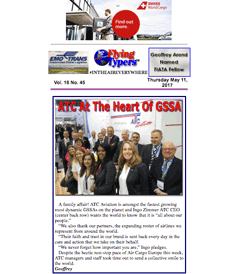

#INTHEAIREVERYWHERE
 |
 #INTHEAIREVERYWHERE |
| Vol. 16 No. 47 | Friday
May 19, 2017 |
DHL So Far, So Good |
Power Surges
However, surges in regional demand
alongside ample supply have led
to highly volatile air freight
rates, albeit rates that are generally
trending upwards. Risks Notwithstanding Asked where he sees potential risks to current positivity, Rahn was instead upbeat. “We have seen an upward demand trend over the past nine months and have no reason to believe that this development will come to an end soon,” he said. “A well-performing world economy and in particular strongly rising consumer confidence suggest that air freight growth will remain.” Minute-By-Minute
“This is also proven by
rather strong demand in the month
of April. In this constellation
the likelihood of falling rates
is minute. E-Commerce Positioned
“E-commerce solutions are
structured to serve the door-to-door
demand for the B2C segment, which
means offering excellent shipment
visibility at piece level, and
well-orchestrated pick-up and
delivery capabilities for small
shipments. As Deutsche Post DHL
Group, we are well positioned
to serve such demand. More Transparency Needed
He said other supply chain stakeholders
could also do more to increase
transparency and efficiency through
the supply chain. Keys & Global Rollout
“The key is to get all involved
parties, including shipper, consignees,
and customs authorities, to agree
to a paperless workflow. While
technically the solution is there,
the capability to replace paper
documents by soft copies is not
yet achieved. As such the air
cargo industry has some work to
do. |
If
You Missed Any Of The
Previous 3 Issues Of
FlyingTypers Access complete issue by clicking on issue icon or Access specific articles by clicking on article title |
||
 Vol. 16 No. 44 Lufthansa Cargo Joint Is Jumping Chuckles for May 10, 2017 Fast Jacques Seizes The Moment Uli @ Qatar Airways Reimagines Cargo 2017 On The Beat @ Air Cargo Europe |
 Vol. 16 No. 45 ATC At The Heart of GSSA Chuckles for May 11, 2017 Emirates Lands Uptick For 2017 Trees Gave It Up For Daily Blah |
|
Publisher-Geoffrey
Arend • Managing Editor-Flossie Arend • Film Editor-Ralph Arend • Special Assignments-Sabiha Arend, Emily Arend • Advertising Sales-Judy Miller |
|